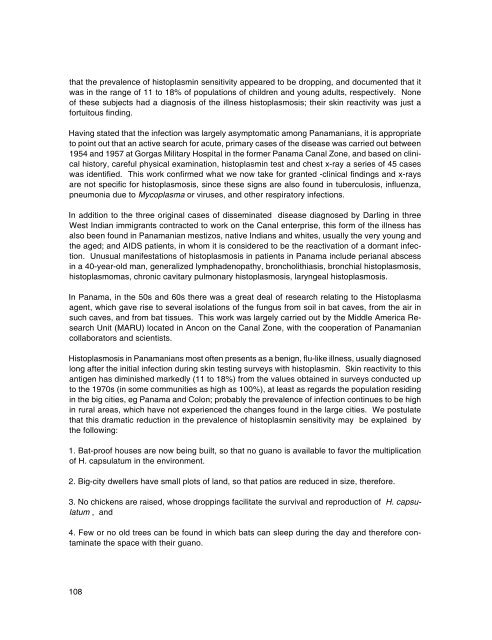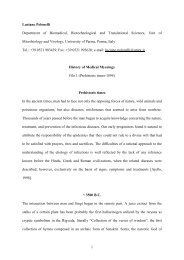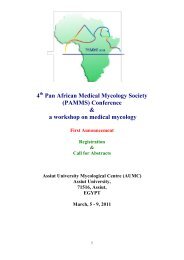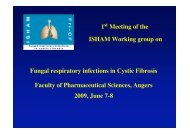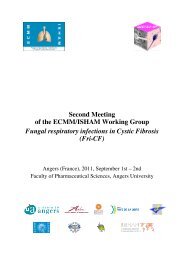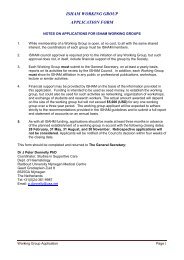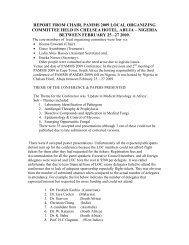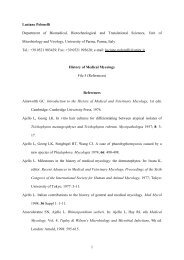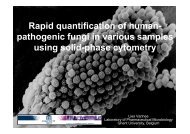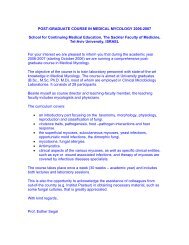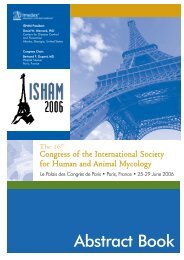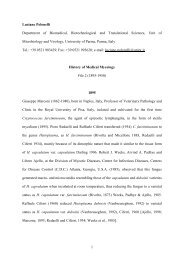Memoria CD.indd - ISHAM
Memoria CD.indd - ISHAM
Memoria CD.indd - ISHAM
Create successful ePaper yourself
Turn your PDF publications into a flip-book with our unique Google optimized e-Paper software.
that the prevalence of histoplasmin sensitivity appeared to be dropping, and documented that itwas in the range of 11 to 18% of populations of children and young adults, respectively. Noneof these subjects had a diagnosis of the illness histoplasmosis; their skin reactivity was just afortuitous finding.Having stated that the infection was largely asymptomatic among Panamanians, it is appropriateto point out that an active search for acute, primary cases of the disease was carried out between1954 and 1957 at Gorgas Military Hospital in the former Panama Canal Zone, and based on clinicalhistory, careful physical examination, histoplasmin test and chest x-ray a series of 45 caseswas identified. This work confirmed what we now take for granted -clinical findings and x-raysare not specific for histoplasmosis, since these signs are also found in tuberculosis, influenza,pneumonia due to Mycoplasma or viruses, and other respiratory infections.In addition to the three original cases of disseminated disease diagnosed by Darling in threeWest Indian immigrants contracted to work on the Canal enterprise, this form of the illness hasalso been found in Panamanian mestizos, native Indians and whites, usually the very young andthe aged; and AIDS patients, in whom it is considered to be the reactivation of a dormant infection.Unusual manifestations of histoplasmosis in patients in Panama include perianal abscessin a 40-year-old man, generalized lymphadenopathy, broncholithiasis, bronchial histoplasmosis,histoplasmomas, chronic cavitary pulmonary histoplasmosis, laryngeal histoplasmosis.In Panama, in the 50s and 60s there was a great deal of research relating to the Histoplasmaagent, which gave rise to several isolations of the fungus from soil in bat caves, from the air insuch caves, and from bat tissues. This work was largely carried out by the Middle America ResearchUnit (MARU) located in Ancon on the Canal Zone, with the cooperation of Panamaniancollaborators and scientists.Histoplasmosis in Panamanians most often presents as a benign, flu-like illness, usually diagnosedlong after the initial infection during skin testing surveys with histoplasmin. Skin reactivity to thisantigen has diminished markedly (11 to 18%) from the values obtained in surveys conducted upto the 1970s (in some communities as high as 100%), at least as regards the population residingin the big cities, eg Panama and Colon; probably the prevalence of infection continues to be highin rural areas, which have not experienced the changes found in the large cities. We postulatethat this dramatic reduction in the prevalence of histoplasmin sensitivity may be explained bythe following:1. Bat-proof houses are now being built, so that no guano is available to favor the multiplicationof H. capsulatum in the environment.2. Big-city dwellers have small plots of land, so that patios are reduced in size, therefore.3. No chickens are raised, whose droppings facilitate the survival and reproduction of H. capsulatum, and4. Few or no old trees can be found in which bats can sleep during the day and therefore contaminatethe space with their guano.108


